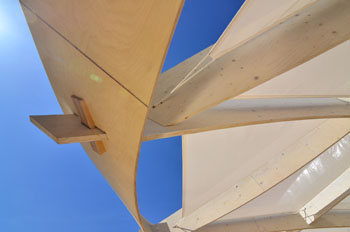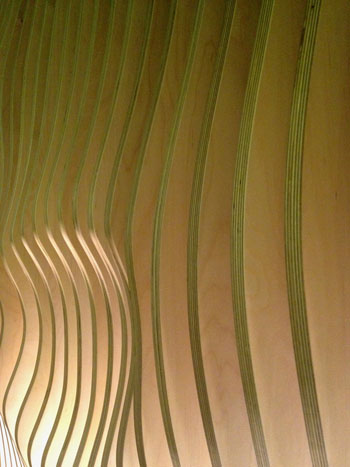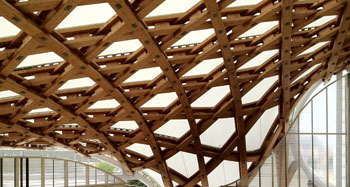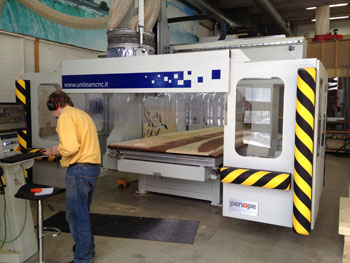CNC ROUTING: ENDLESS POSSIBILITIES
CNC (Computer Numerical Control) routing is emerging as a powerful tool for designers and builders to utilise and exploit, thus providing a distinct design advantage. This artistry should be treated like any other; one which calls for the combination of special skill and careful planning, to ensure a successful outcome. As with all trades, a CNC operator has a specific set of practical skills and tools which we, as designers, do not necessarily possess. But we can benefit from their use.
Wood crafting is perfectly suited for CNC milling. All the features of timber that facilitate wood manipulation with hand tools are exploited by CNC machines. Although the technology has existed for years, innovations have facilitated larger and more powerful machines and thus the common use of CNC wood routing in architecture and design.

Kierre Pavilion employed a very low-tolerance joint system thanks to CNC technology
Photo: Nicolas Pratt
Presently, common CNC machines have the ability to cut in 5 or 6 directions, or axes. Consequently, complex forms - ones which are curved and angled in varying configurations - are possible. Automated drill heads move above and around a stationary wooden piece, cutting away at it where necessary. Drill bit movement is dictated through CAD/CAM software in 3D coordinates (x,y,z).
CNC routing can be utilised for more or less any wood type or wood product – composites included. The CNC craft has evolved from being used for small ornamental pieces, to furniture, to architecturally designed features and is now used to create complex wooden structural members. Consequently, the main limitations of wood design have shifted away from how skilful a craftsman’s hands are, to more pragmatic considerations such as machine size and space limitations.

CNC routed plywood for this architectural ornament by Ora-Ito
Photo: Takahiro_Minamino
The most exciting feature of CNC routing is obviously the potential for complex cuts. This can result in highly intricate ornamental features or very reliable joint systems, to name two examples. However, CNC isn’t an all-encompassing wonder-tool, as commonly perceived. Transportation of both raw material and cut objects to and from CNC milling factories is still a major logistical consideration. Similarly, the need for physical labour has not been eliminated. Lifting timber members on, off, through, up and over the machine is still heavy work. Additionally, the translation of drawings from architectural standards to formats CNC software can read is also a laborious task.

CNC at all scales. Pompidou Metz was very reliant on large scale CNC milling
Photo: Nicolas Pratt
Working with CNC cutting:
Although precision and efficiency are dramatically improved in the production phase, planning should still match that of more traditional crafts for best results. Working closely with your manufacturer will ensure efficient design development.
CNC operations can vary from single-person to large commercial businesses. So pick an operator who will suit your needs. Most operators are always up for a challenge. An architect proposing a complex job will be well-received by an operator who typically spends long days cutting multitudes of fence posts and endless ornamental doors!

A typical small CNC operation
Photo: Nicolas Pratt
It is important to become familiar with the system’s limitations. Like great architectural projects, constraints should be what drive the design of a CNC cut architectural feature. Whether it’s Glulam structural beams or a plywood wall, considerations such as material size verses machine bed size and the necessity of angled cuts should be made. It is important to gather as much information as possible early in the process; the time and cost of a CNC cut can dramatically increase when angled cuts are introduced into the design.
Table sizes for the machines can vary greatly. However, a cutting area of 1.5m(W) x 4m(L) x 1m(H) is a reasonable starting expectation.
CNC routing is definitely a mainstay of future wood construction. Its reliability, speed and accuracy cannot be matched by more traditional crafting techniques. In addition to facilitating new building methods and identities, CNC routing extends the potential of timber.
